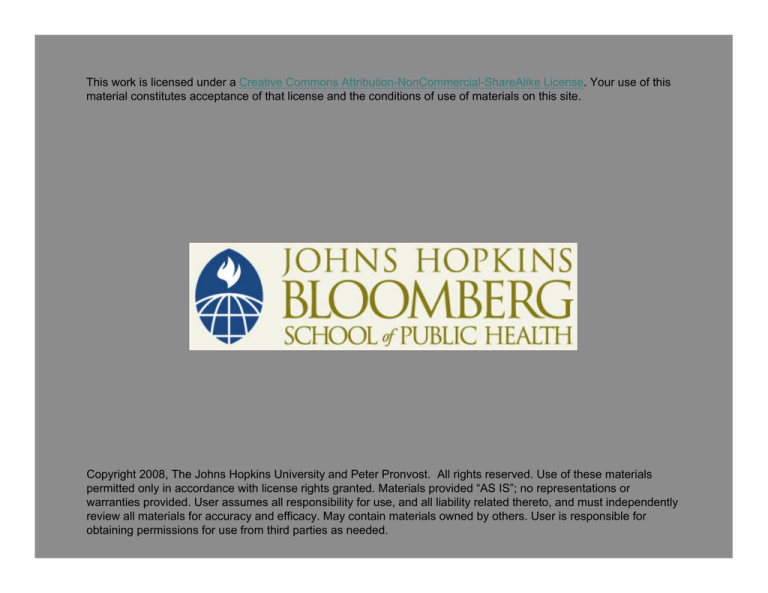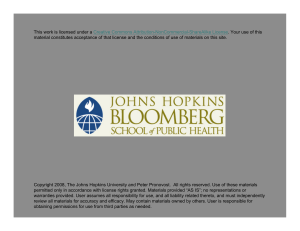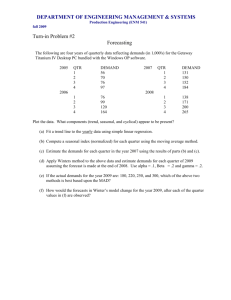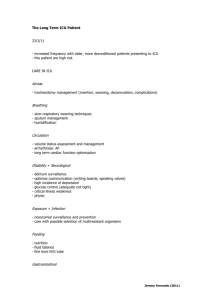
This work is licensed under a Creative Commons Attribution-NonCommercial-ShareAlike License. Your use of this
material constitutes acceptance of that license and the conditions of use of materials on this site.
Copyright 2008, The Johns Hopkins University and Peter Pronvost. All rights reserved. Use of these materials
permitted only in accordance with license rights granted. Materials provided “AS IS”; no representations or
warranties provided. User assumes all responsibility for use, and all liability related thereto, and must independently
review all materials for accuracy and efficacy. May contain materials owned by others. User is responsible for
obtaining permissions for use from third parties as needed.
Safety and Medicine
Peter Pronovost, MD, PhD
Johns Hopkins University
The Problem Is Large
In U.S. health care system
− 44,000–98,000 deaths
− $50 billion in total costs
Similar results in Australia and the U.K.
3
RAND Study Confirms Continued Quality Gap
Condition
Percentage of
Recommended Care Received
Low back pain
Coronary artery disease
68.5
68.0
Hypertension
Depression
Orthopedic conditions
Colorectal cancer
Asthma
Benign prostatic hyperplasia
Hyperlipidemia
Diabetes mellitus
Headaches
Urinary tract infection
Hip fracture
Alcohol dependence
64.7
57.7
57.2
53.9
53.5
53.0
48.6
45.4
45.2
40.7
22.8
10.5
Source: McGlynn et al. (2003). New England Journal of Medicine, 348, 26, 2635–2645.
4
Preventable Deaths
172,263 preventable deaths in the ICU from failing to use five
interventions
Care process
% not receiving
Preventable deaths
ICU physician
77%
134,640
Sepsis drug
89%
10,311
Steroids in sepsis
50%
9,500
Glucose control
75%
12,347
Low tidal volume in ARDS
70%
5,465
Source: Pronovost. (2004).
5
How Can This Happen?
How can this happen?
Need to view the delivery
of health care as a science
6
How Can We Improve?
How can we improve?
The system is a set of parts interacting to
achieve a goal
Every system is perfectly designed to achieve
the results it gets
Caregivers are not to blame
7
System Failure Leading to Error
Communication between
resident and nurse
Inadequate training
and supervision
Patient suffers
venous air embolism
Source: Pronovost. (2004). Annals of Internal Medicine.
Lack of protocol
for catheter removal
Catheter
pulled with
patient sitting
8
System Factors Impact Safety
Institutional
Hospital
Departmental Factors
Work Environment
Team Factors
Individual Provider
Task Factors
Patient Characteristics
9
Medication Error Waiting to Happen
Esmolol HCl (Brevibloc) distributed in dilute form and
concentrated form
Similar packaging for both, resulting in easy confusion and
dosing errors (http://www.fda.gov/medbull/mederror.html)
10
Impact of ICU Organization on Performance
Physicians
Nurses
Pharmacists
Source: Pronovost. (1999). JAMA; Pronovost. (2001) ECP.
11
Aviation Accidents per Million Departures (1959–2001)
U.S. and Canadian operators
Rest of the world
12
% of respondents reporting aboveadequate teamwork
ICU Physicians and ICU RN Collaboration
100
90
80
70
60
50
40
30
20
10
0
90%
54%
RN rates ICU Physician
Source: Intensive Care Unit Safety Reporting System (ICUSRS).
KP L&D
ICU Physician rates RN
13
Reliability Contingent upon Culture of Safety
To improve reliability from 10-1 to 10-3 is contingent upon
culture of safety
− Standardize what is done, when it is done
X Reduce complexity
− Create independent checks for key processes
X How often do we do what we should
− Learn from defects
X How often do we learn from defects
14
Reliability Contingent upon Culture of Safety
To improve reliability from 10-1 to 10-3 is contingent upon
culture of safety
− Standardize what is done, when it is done
X Reduce complexity
− Create independent checks for key processes
X How often do we do what we should
− Learn from defects
X How often do we learn from defects
15
Improving Reliability
Standardize
Glucose protocol
80% compliance
Defects 10-1
Independent
check
Independent check
by nurse, pharmacist
98% compliance
Defects 10-2
Failure mode analysis
glucose rounds
99.9% compliance
Defects 10-3
Learn from defects
16
Daily goals
2003 - Qtr1
Line cart
2002 - Qtr3
25
2002 - Qtr1
2001 - Qtr3
15
2001 - Qtr1
2000 - Qtr3
2000 - Qtr1
20
1999 - Qtr3
1999 - Qtr1
1998 - Qtr3
1998 - Qtr1
Rate per 1000 cath days
CR-BSI Rate
VAD policy
Checklist
Empower
nursing
10
5
0
17
Summary of Science of Safety
Accept that we will make mistakes
Focus on systems rather than blame
Speak up if you have concerns, listen when others do
Create clear goals, ask questions early
Standardize, create independent checks, and learn from
mistakes
www.icusrs.org
18








